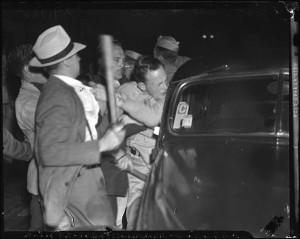By Courtney Horton/reporter
A riot during the summer of 1943 on the homefront while Americans were fighting against the racially intolerant Nazis had national as well as international implications, a University of Texas at Dallas professor told SE students Oct. 7.
Monica Rankin described the violence the Zoot Suit Riot of Los Angeles caused among Americans during World War II.
“This would be a time when few would question whether the United States came out on the right side of history,” she said. “This is a time when the U.S. military confronted the evil Axis forces on the battlefields of Europe.”
But trouble was brewing at home in Los Angeles.
“This was the sight of very problematic ethnic tensions that boiled over simultaneously being played out in the battlefields of Europe,” she said.
Rankin said the conflict centered around a group known as Pachucos.
“Pachucos, by definition, were Mexican-American youth, adolescents, teenagers and young adults,” she said.
This was a common term used for Mexican-Americans, mainly men who fell within the ages of 13-23, roughly around the time of the 1930s to the 1960s.
“Pachucos were associated rightly or wrongly with gang activity,” she said. “They were very flamboyant, both in their behavior and their dress. They created their own language, their own slang.”
That language was a combination of both English and Spanish, but they were mostly known by what they wore — the Zoot suit, Rankin said.
“High-waist baggy pants, high above the ankle, and oversized blazer, enormous shoulder pads and a tail that would often go down to their knees,” she said. “Bright colors and large accessories, chains that go down to their ankles and enormous bow tie.”
The Zoot suit made a social statement, particularly when the country was under wartime rationing and shortages. Anytime cloth would appear over other cloth — pleats, cuffs and double-breasted jackets as on the Zoot suit — this was considered to be excess use, Rankin said.
“People around the United States wanting to demonstrate their patriotism gladly wanted to adopt new fashion styles of less cloth, more tailored-fit material,” she said.
They looked against people who didn’t adopt the same fashion sense that they did, saying they didn’t support what the United States was standing for during World War II.

“On that evening [June 4], violence broke out between a small group of Pachucos in their Zoot suits and Navy servicemen who were preparing to leave to go overseas to fight for them,” she said. “Minor injuries were reported, but the press reported something completely different.”
The press said the Pachucos violently attacked the sailors who were set to leave for overseas to go fight in the war. Rankin said the reporters called the Pachucos unpatriotic and ruthless and said they were the instigators of this violence against these patriot military men.
“On the following evening, other groups of Caucasian males, mainly sailors but some civilians, begin gathering together,” she said.
Some drove their own cars and some took taxis, thus, becoming known as the taxicab brigade. They drove around the Pachuco neighborhood looking for the specific Zoot suits and would attack them.
“The local reaction was immediate,” she said. “The mayor of Los Angeles and military released a statement placing blame on the so-called Pachucos.”
Rankin said the Axis press covered this very heavily in a slanted way.
“According to these Axis reports, clearly the United States had a race problem, and Latinos were victims in that problem,” she said.
All of this information made it back to the United States very quickly, Rankin said, and everyone reacted very quickly to these accusations.
In 1943, Mexico was part of the formal alliance with the United States against the Axis.
“This concerned a lot of people, and it got national attention from President Roosevelt,” she said. “He immediately got in touch with a new diplomatic office that had been formed at the beginning of World War II to handle all U.S. relations,” she said.
Roosevelt contacted Nelson Rockefeller, the head of the Office of the Coordinator of Inter-American Affairs, and told him to get the situation under control, Rankin said.
“Their primary function during World War II was to improve U.S. relations with Latin America,” she said. “The mayor of Los Angeles soon contacted the Mexican council and personally apologized.”
The Mexicans firmly believed that the press portrayed the Pachucos in a bad light, Rankin said.
Although society can see changes, Rankin said some things still need improvement.


























